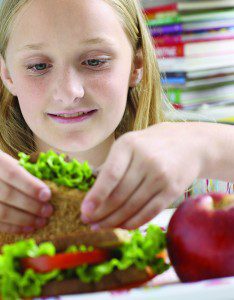 As autumn approaches, children are heading back to school. Because children spend much of their time in classrooms, schools are an ideal setting to teach and model healthy behaviors. As children across the country get ready to return to school, parents and staff can gear up to improve the health of students and help them achieve academic success.
As autumn approaches, children are heading back to school. Because children spend much of their time in classrooms, schools are an ideal setting to teach and model healthy behaviors. As children across the country get ready to return to school, parents and staff can gear up to improve the health of students and help them achieve academic success.
There are a number of ways parents and the school staff can make healthy living easier where kids learn and play. Small changes such as incorporating fun movements into short “physical activity” breaks between lessons or adding more healthy options in the cafeteria can have a collective impact on a school’s environment.
Michelle Jones, a mother of two students at Roots Charter School in Washington, DC, recognized the need for the school to provide more opportunities for physical activity throughout the school day. “The obesity rate among children is at an all-time high, so getting our kids to be active is more crucial than ever,” said Michelle. “I want to make sure my children live their lives to the fullest, and getting exercise can help them do that.”
What Parents Can Do to Support Healthier Schools
• Ask that water be made available throughout the day.
• Encourage teachers and administrators to reward kids with extra recess, fun pencils and erasers, or time for a special game—rather than with sweet treats.
• Encourage kids to sign up for after-school sports, running clubs, and other physical activity opportunities offered by the school—or volunteer to lead such activities.
• Talk with neighbors about forming a walking school bus—taking turns walking with groups of children to and from school.
• Support safe walking and biking routes to school if the community does not already have them.
Michelle met with other parents to form an advisory council that works with local schools to host events focusing on health and wellness. Activities like yoga, Zumba, and farm-to-school programs inspire students, parents, and community members to be physically active and make healthier food choices.
Such improvements can help prevent obesity—a serious and growing public health concern that increases a child’s chance of type 2 diabetes, heart disease, and other health problems.
Nutrition Improvements
With help from the Centers for Disease Control and Prevention (CDC), communities all over the country are making improvements in school wellness. When it comes to nutrition, schools are raising the standards to make school breakfast and lunch healthier. For example, the Tri-County Health Department in Colorado has worked with 14 school districts in the area to ensure healthier foods and beverages are served in school. Schools are now offering nutritious fruits, vegetables, whole grains, and nonfat or low-fat milk. The districts also encourage non-food or healthy food-related parties or rewards in the classroom.
Additionally, the Minnesota Department of Health has made healthier foods and beverages available to students at schools across the state, even in the most rural areas. Schools are decreasing sodium, saturated fat, and sugar intake and increasing access to fruits and vegetables, through farm-to-school programs, school gardens, and salad bars.
Physical Activity Improvements
In addition to making substantial strides in nutrition, many schools are also finding ways for students to become more active. For example, the David Douglas School District in Multnomah County, Oregon, now requires at least 150 minutes per week of physical activity for elementary and middle school students. Also, students in the Eastern Band of Cherokee Indians school system in North Carolina now receive 150–225 minutes of physical education each week, which meets the National Standards for Physical Education for grades K-12.
Some schools are making improvements both inside and outside the school. The West Adams-Baldwin Hills-Leimert and South Los Angeles areas of California are developing Healthy Kids Zones within at least a 1-mile radius around eight schools. These zones will provide opportunities for active transportation such as walking and biking and greater access to healthier foods at corner stores.
Healthy Students are Better Learners
Eating well and participating in regular physical activity not only has health benefits, but also has been linked to better academic achievement by enhancing important skills like concentration and attentiveness. For example, students who eat foods rich in protein, vitamins, and minerals are more likely to perform better than students whose diets are heavy in unhealthy foods—like sweets and fried foods. Eating healthy foods and being physically active can result in decreased rates of student absenteeism, fewer behavioral problems, and higher school-wide test scores and grades.
The Division of Community Health is dedicated to making healthy living easier where Americans live, learn, work, and play. Although changes are already being made in some schools around the country, more can be done. Learn more about how parents can help improve health in their local schools and communities at MakingHealthEasier.org. For additional resources about the CDC’s work to help build healthier school environments, visit Division of Nutrition, Physical Activity, and Obesity at CDC.gov.
Source: CDC.gov









